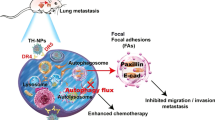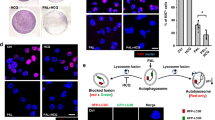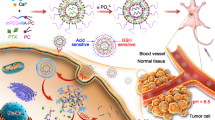Abstract
Despite improvements in our understanding of the biology behind triple-negative breast cancer (TNBC), it remains a devastating disease due to lack of an effective targeted therapy. Inhibiting Wnt signaling is a promising strategy to combat TNBC because Wnt signaling drives TNBC progression, chemoresistance, and stemness. However, Wnt inhibition can lead to upregulation of autophagy, which confers therapeutic resistance. This provides an opportunity for combination therapy, as autophagy inhibitors applied concurrently with Wnt inhibitors could increase treatment efficacy. Here, we applied the autophagy inhibitor chloroquine (CQ) to TNBC cells in combination with Frizzled7 antibody-coated nanoshells (FZD7-NS) that suppress Wnt signaling by blocking Wnt ligand/FZD7 receptor interactions, and evaluated this dual treatment in vitro. We found that FZD7-NS can inhibit Axin2 and CyclinD1, two targets of canonical Wnt signaling, and increase the expression of LC3, an autophagy marker. When FZD7-NS and CQ are applied together, they reduce the expression of several stemness genes in TNBC cells, leading to inhibition of TNBC cell migration and self-renewal. Notably, co-delivery of FZD7-NS and CQ is more effective than either therapy alone or the combination of CQ with free FZD7 antibodies. This demonstrates that the nanocarrier design is important to its therapeutic utility. Overall, these findings indicate that combined regulation of Wnt signaling and autophagy by FZD7-NS and CQ is a promising strategy to combat TNBC.

Similar content being viewed by others
References
Anders, C. K.; Carey, L. A. Biology, metastatic patterns, and treatment of patients with triple-negative breast cancer. Clin. Breast Cancer2009, 9, S73–S81.
Dent, R.; Hanna, W. M.; Trudeau, M.; Rawlinson, E.; Sun, P.; Narod, S. A. Pattern of metastatic spread in triple-negative breast cancer. Breast Cancer Res. Treat.2009, 115, 423–428.
Pohl, S. G.; Brook, N.; Agostino, M.; Arfuso, F.; Kumar, A. P.; Dharmarajan, A. Wnt signaling in triple-negative breast cancer. Oncogenesis2017, 6, e310.
Dey, N.; Barwick, B. G.; Moreno, C. S.; Ordanic-Kodani, M.; Chen, Z. J.; Oprea-Ilies, G.; Tang, W. N.; Catzavelos, C.; Kerstann, K. F.; Sledge, G. W. et al. Wnt signaling in triple negative breast cancer is associated with metastasis. BMC Cancer2013, 13, 537.
King, T. D.; Suto, M. J.; Li, Y. H. The Wnt/β-catenin signaling pathway: A potential therapeutic target in the treatment of triple negative breast cancer. J. Cell. Biochem.2012, 113, 13–18.
Yang, L.; Wu, X.; Wang, Y.; Zhang, K.; Wu, J.; Yuan, Y. C.; Deng, X.; Chen, L.; Kim, C. C. H.; Lau, S. et al. FZD7 has a critical role in cell proliferation in triple negative breast cancer. Oncogene2011, 30, 4437–4446.
Riley, R. S.; Day, E. S. Frizzled7 antibody-functionalized nanoshells enable multivalent binding for Wnt signaling inhibition in triple negative breast cancer cells. Small2017, 13, 1700544.
Ma, B.; Hottiger, M. O. Crosstalk between Wnt/β-catenin and NF-κB signaling pathway during inflammation. Front. Immunol.2016, 7, 378.
Morris, S. A. L.; Huang, S. Y. Crosstalk of the Wnt/β-catenin pathway with other pathways in cancer cells. Genes Dis.2016, 3, 41–47.
Jeong, W. J.; Ro, E. J.; Choi, K. Y. Interaction between Wnt/β-catenin and RAS-ERK pathways and an anti-cancer strategy via degradations of β-catenin and RAS by targeting the Wnt/β-catenin pathway. NPJ Precis. Oncol.2018, 2, 5.
Nàger, M.; Sallán, M. C.; Visa, A.; Pushparaj, C.; Santacana, M.; Macià, A.; Yeramian, A.; Cantí, C.; Herreros, J. Inhibition of Wnt-CTNNB1 signaling upregulates SQSTM1 and sensitizes glioblastoma cells to autophagy blockers. Autophagy2018, 14, 619–636.
Petherick, K. J.; Williams, A. C.; Lane, J. D.; Ordóñez-Morán, P.; Huelsken, J.; Collard, T. J.; Smartt, H. J. M.; Batson, J.; Malik, K.; Paraskeva, C. et al. Autolysosomal β-catenin degradation regulates Wnt-autophagy-p62 crosstalk. EMBO J.2013, 32, 1903–1916.
Turcios, L.; Chacon, E.; Garcia, C.; Eman, P.; Cornea, V.; Jiang, J. Y.; Spear, B.; Liu, C. M.; Watt, D. S.; Marti, F. et al. Autophagic flux modulation by Wnt/β-catenin pathway inhibition in hepatocellular carcinoma. PLoS One2019, 14, e0212538.
Fu, Y. J.; Chang, H.; Peng, X. L.; Bai, Q.; Yi, L.; Zhou, Y.; Zhu, J. D.; Mi, M. T. Resveratrol inhibits breast cancer stem-like cells and induces autophagy via suppressing Wnt/β-catenin signaling pathway. PLoS One2014, 9, e102535.
Su, N.; Wang, P. P.; Li, Y. Role of Wnt/β-catenin pathway in inducing autophagy and apoptosis in multiple myeloma cells. Oncol. Lett.2016, 12, 4623–4629.
Ávalos, Y.; Canales, J.; Bravo-Sagua, R.; Criollo, A.; Lavandero, S; Quest, A. F. G. Tumor suppression and promotion by autophagy. BioMed Res. Int.2014, 2014, 603980.
Chittaranjan, S.; Bortnik, S.; Dragowska, W. H.; Xu, J.; Abeysundara, N.; Leung, A.; Go, N. E.; DeVorkin, L.; Weppler, S. A.; Gelmon, K. et al. Autophagy inhibition augments the anticancer effects of epirubicin treatment in anthracycline-sensitive and -resistant triple-negative breast cancer. Clin. Cancer Res.2014, 20, 3159–3173.
Rubinsztein, D. C.; Codogno, P.; Levine, B. Autophagy modulation as a potential therapeutic target for diverse diseases. Nat. Rev. Drug Discov.2012, 11, 709–730.
Oldenburg, S. J.; Averitt, R. D.; Westcott, S. L.; Halas, N. J. Nanoengineering of optical resonances. Chem. Phys. Lett.1998, 288, 243–247.
Melamed, J. R.; Ioele, S. A.; Hannum, A. J.; Ullman, V. M.; Day, E. S. Polyethylenimine-spherical nucleic acid nanoparticles against GLI1 reduce the chemoresistance and stemness of glioblastoma cells. Mol. Pharm.2018, 15, 5135–5145.
Manders, E. M. M.; Verbeek, F. J.; Aten, J. A. Measurement of co-localization of objects in dual-colour confocal images. J. Microsc.1993, 169, 375–382.
Stauffer, W.; Sheng, H. J.; Lim, H. N. EzColocalization: An ImageJ plugin for visualizing and measuring colocalization in cells and organisms. Sci. Rep.2018, 8, 15764.
Wang, J. X.; Potocny, A. M.; Rosenthal, J.; Day, E. S. Gold nanoshell-linear tetrapyrrole conjugates for near infrared-activated dual photodynamic and photothermal therapies. ACS Omega2020, 5, 926–940.
Riley, R. S.; Melamed, J. R.; Day, E. S. Enzyme-linked immunosorbent assay to quantify targeting molecules on nanoparticles. In Targeted Drug Delivery: Methods and Protocols. Sirianni, R. W.; Behkam, B., Eds.; Humana Press: New York, NY, 2018; pp 145–157.
de Puig, H.; Bosch, I.; Carré-Camps, M.; Hamad-Schifferli, K. Effect of the protein corona on antibody-antigen binding in nanoparticle sandwich immunoassays. Bioconjugate Chem.2017, 28, 230–238.
Sahay, G.; Alakhova, D. Y.; Kabanov, A. V. Endocytosis of nanomedicines. J. Control. Release2010, 145, 182–195.
Oh, E.; Delehanty, J. B.; Sapsford, K. E.; Susumu, K.; Goswami, R.; Blanco-Canosa, J. B.; Dawson, P. E.; Granek, J.; Shoff, M.; Zhang, Q. et al. Cellular uptake and fate of PEGylated gold nanoparticles is dependent on both cell-penetration peptides and particle size. ACS Nano2011, 5, 6434–6448.
Chithrani, D. B. Intracellular uptake, transport, and processing of gold nanostructures. Mol. Membr. Biol.2010, 27, 299–311.
Nativo, P.; Prior, I. A.; Brust, M. Uptake and intracellular fate of surface-modified gold nanoparticles. ACS Nano2008, 2, 1639–1644.
Wang, L. M.; Liu, Y.; Li, W.; Jiang, X. M.; Ji, Y. L.; Wu, X. C.; Xu, L. G.; Qiu, Y.; Zhao, K.; Wei, T. T. et al. Selective targeting of gold nanorods at the mitochondria of cancer cells: Implications for cancer therapy. Nano Lett.2011, 11, 772–780.
Frantz, M. C.; Wipf, P. Mitochondria as a target in treatment. Environ. Mol. Mutagen.2010, 51, 462–475.
Weinberg, S. E.; Chandel, N. S. Targeting mitochondria metabolism for cancer therapy. Nat. Chem. Biol.2015, 11, 9–15.
Fulda, S.; Galluzzi, L.; Kroemer, G. Targeting mitochondria for cancer therapy. Nat. Rev. Drug Discov.2010, 9, 447–464.
Murphy, M. P.; Hartley, R. C. Mitochondria as a therapeutic target for common pathologies. Nat. Rev. Drug Discov.2018, 17, 865–886.
Pathak, R. K.; Kolishetti, N.; Dhar, S. Targeted nanoparticles in mitochondrial medicine. Wiley Interdiscip. Rev. Nanomed. Nanobiotechnol.2015, 7, 315–329.
Marrache, S.; Pathak, R. K.; Dhar, S. Formulation and optimization of mitochondria-targeted polymeric nanoparticles. In Mitochondrial Medicine: Volume II, Manipulating Mitochondrial Function. Weissig, V.; Edeas, M., Eds.; Humana Press: New York, 2015; pp 103–112.
Picard, M.; Wallace, D. C.; Burelle, Y. The rise of mitochondria in medicine. Mitochondrion2016, 30, 105–116.
Gao, C.; Cao, W. P.; Bao, L.; Zuo, W.; Xie, G. M.; Cai, T. T.; Fu, W.; Zhang, J.; Wu, W.; Zhang, X. et al. Autophagy negatively regulates Wnt signalling by promoting Dishevelled degradation. Nat. Cell Biol.2010, 12, 781–790.
Bilir, B.; Kucuk, O.; Moreno, C. S. Wnt signaling blockage inhibits cell proliferation and migration, and induces apoptosis in triple-negative breast cancer cells. J. Transl. Med.2013, 11, 280.
Liu, C. G.; Sun, L. S.; Yang, J.; Liu, T.; Yang, Y. L.; Kim, S. M.; Ou, X. Y.; Wang, Y. N.; Sun, L.; Zaidi, M. et al. FSIP1 regulates autophagy in breast cancer. Proc. Natl. Acad. Sci. USA2018, 115, 13075–13080.
Reya, T.; Morrison, S. J.; Clarke, M. F.; Weissman, I. L. Stem cells, cancer, and cancer stem cells. Nature2001, 414, 105–111.
Reya, T.; Clevers, H. Wnt signalling in stem cells and cancer. Nature2005, 434, 843–850.
Pan, H. Z.; Cai, N.; Li, M.; Liu, G. H.; Izpisua Belmonte, J. C. Autophagic control of cell ‘stemness’. EMBO Mol. Med.2013, 5, 327–331.
García-Prat, L.; Martínez-Vicente, M.; Perdiguero, E.; Ortet, L.; Rodríguez-Ubreva, J.; Rebollo, E.; Ruiz-Bonilla, V.; Gutarra, S.; Ballestar, E.; Serrano, A. L. et al. Autophagy maintains stemness by preventing senescence. Nature2016, 529, 37–42.
Desai, A.; Yan, Y.; Gerson, S. L. Concise reviews: Cancer stem cell targeted therapies: Toward clinical success. Stem Cells Transl. Med.2019, 8, 75–81.
Saygin, C.; Matei, D.; Majeti, R.; Reizes, O.; Lathia, J. D. Targeting cancer stemness in the clinic: From hype to hope. Cell Stem Cell2019, 24, 25–40.
Yu, F.; Li, J.; Chen, H.; Fu, J.; Ray, S.; Huang, S.; Zheng, H.; Ai, W. Kruppel-like factor 4 (KLF4) is required for maintenance of breast cancer stem cells and for cell migration and invasion. Oncogene2011, 30, 2161–2172.
Nagata, T.; Shimada, Y.; Sekine, S.; Moriyama, M.; Hashimoto, I.; Matsui, K.; Okumura, T.; Hori, T.; Imura, J.; Tsukada, K. KLF4 and NANOG are prognostic biomarkers for triple-negative breast cancer. Breast Cancer2017, 24, 326–335.
Lu, X.; Mazur, S. J.; Lin, T.; Appella, E.; Xu, Y. The pluripotency factor Nanog promotes breast cancer tumorigenesis and metastasis. Oncogene2014, 33, 2655–2664.
Zhang, J. M.; Wei, K.; Jiang, M. OCT4 but not SOX2 expression correlates with worse prognosis in surgical patients with triple-negative breast cancer. Breast Cancer2018, 25, 447–455.
Cheng, C. C.; Shi, L. H.; Wang, X. J.; Wang, S. X.; Wan, X. Q.; Liu, S. R.; Wang, Y. F.; Lu, Z.; Wang, L. H.; Ding, Y. Stat3/Oct-4/c-Myc signal circuit for regulating stemness-mediated doxorubicin resistance of triple-negative breast cancer cells and inhibitory effects of WP1066. Int. J. Oncol.2018, 53, 339–348.
Imrich, S.; Hachmeister, M.; Gires, O. EpCAM and its potential role in tumor-initiating cells. Cell Adh. Migr.2012, 6, 30–38.
Osta, W. A.; Chen, Y.; Mikhitarian, K.; Mitas, M.; Salem, M.; Hannun, Y. A.; Cole, D. J.; Gillanders, W. E. EpCAM is overexpressed in breast cancer and is a potential target for breast cancer gene therapy. Cancer Res.2004, 64, 5818–5824.
Lobba, A. R. M.; Forni, M. F.; Carreira, A. C. O.; Sogayar, M. C. Differential expression of CD90 and CD14 stem cell markers in malignant breast cancer cell lines. Cytometry A2012, 81, 1084–1091.
Lu, H. H.; Clauser, K. R.; Tam, W. L.; Fröse, J.; Ye, X.; Eaton, E. N.; Reinhardt, F.; Donnenberg, V. S.; Bhargava, R.; Carr, S. A. et al. A breast cancer stem cell niche supported by juxtacrine signalling from monocytes and macrophages. Nat. Cell Biol.2014, 16, 1105–1117.
Wheatley, S. P.; Altieri, D. C. Survivin at a glance. J. Cell Sci.2019, 132, jcs223826.
Cho, Y. H.; Han, K. M.; Kim, D.; Lee, J.; Lee, S. H.; Choi, K. W.; Kim, J.; Han, Y. M. Autophagy regulates homeostasis of pluripotency-associated proteins in hESCs. Stem Cells2014, 32, 424–435.
Liu, C. C.; DeRoo, E. P.; Stecyk, C.; Wolsey, M.; Szuchnicki, M.; Hagos, E. G. Impaired autophagy in mouse embryonic fibroblasts null for Krüppel-like Factor 4 promotes DNA damage and increases apoptosis upon serum starvation. Mol. Cancer2015, 14, 101.
Hsieh, P. N.; Zhou, G. J.; Yuan, Y. Y.; Zhang, R. L.; Prosdocimo, D. A.; Sangwung, P.; Borton, A. H.; Boriushkin, E.; Hamik, A.; Fujioka, H. et al. A conserved KLF-autophagy pathway modulates nematode lifespan and mammalian age-associated vascular dysfunction. Nat. Commun.2017, 8, 914.
Hasmim, M.; Janji, B.; Khaled, M.; Noman, M. Z.; Louache, F.; Bordereaux, D.; Abderamane, A.; Baud, V.; Mami-Chouaib, F.; Chouaib, S. Cutting edge: NANOG activates autophagy under hypoxic stress by binding to BNIP3L promoter. J. Immunol.2017, 198, 1423–1428.
Liao, X. D.; Zhang, R. L.; Lu, Y.; Prosdocimo, D. A.; Sangwung, P.; Zhang, L. L.; Zhou, G. J.; Anand, P.; Lai, L.; Leone, T. C. et al. Kruppel-like factor 4 is critical for transcriptional control of cardiac mitochondrial homeostasis. J. Clin. Invest.2015, 125, 3461–3476.
Kumar, A.; Bhanja, A.; Bhattacharyya, J.; Jaganathan, B. G. Multiple roles of CD90 in cancer. Tumor Biol.2016, 37, 11611–11622.
van der Gun, B. T. F.; Melchers, L. J.; Ruiters, M. H. J.; de Leij, L. F. M. H.; McLaughlin, P. M. J.; Rots, M. G. EpCAM in carcinogenesis: The good, the bad or the ugly. Carcinogenesis2010, 31, 1913–1921.
Garg, H.; Suri, P.; Gupta, J. C.; Talwar, G. P.; Dubey, S. Survivin: A unique target for tumor therapy. Cancer Cell Int.2016, 16, 49.
Siddharth, S.; Das, S.; Nayak, A.; Kundu, C. N. SURVIVIN as a marker for quiescent-breast cancer stem cells—An intermediate, adherent, pre-requisite phase of breast cancer metastasis. Clin. Exp. Meta.2016, 33, 661–675.
Levy, J. M. M.; Towers, C. G.; Thorburn, A. Targeting autophagy in cancer. Nat. Rev. Cancer2017, 17, 528–542.
Lefort, S.; Joffre, C.; Kieffer, Y.; Givel, A. M.; Bourachot, B.; Zago, G.; Bieche, I.; Dubois, T.; Meseure, D.; Vincent-Salomon, A. et al. Inhibition of autophagy as a new means of improving chemotherapy efficiency in high-LC3B triple-negative breast cancers. Autophagy2014, 10, 2122–2142.
O’Reilly, E. A.; Gubbins, L.; Sharma, S.; Tully, R.; Guang, M. H. Z.; Weiner-Gorzel, K.; McCaffrey, J.; Harrison, M.; Furlong, F.; Kell, M. et al. The fate of chemoresistance in triple negative breast cancer (TNBC). BBA Clin.2015, 3, 257–275.
Pérez-Hernández, M.; Arias, A.; Martínez-García, D.; Pérez-Tomás, R.; Quesada, R.; Soto-Cerrato, V. Targeting autophagy for cancer treatment and tumor chemosensitization. Cancers2019, 11, 1599.
Pelt, J.; Busatto, S.; Ferrari, M.; Thompson, E. A.; Mody, K.; Wolfram, J. Chloroquine and nanoparticle drug delivery: A promising combination. Pharmacol. Ther.2018, 191, 43–49.
Abdullah, L. N.; Chow, E. K. H. Mechanisms of chemoresistance in cancer stem cells. Clin. Transl. Med.2013, 2, 3.
Zhou, Z.; Feng, Z. W.; Hu, D.; Yang, P.; Gur, M.; Bahar, I.; Cristofanilli, M.; Gradishar, W. J.; Xie, X. Q.; Wan, Y. A novel small-molecule antagonizes PRMT5-mediated KLF4 methylation for targeted therapy. EBioMedicine2019, 44, 98–111.
Choi, D. S.; Blanco, E.; Kim, Y. S.; Rodriguez, A. A.; Zhao, H.; Huang, T. H. M.; Chen, C. L.; Jin, G. X.; Landis, M. D.; Burey, L. A. et al. Chloroquine eliminates cancer stem cells through deregulation of Jak2 and DNMT1. STEM CELLS2014, 32, 2309–2323.
Bouchard, G.; Therriault, H.; Geha, S.; Bérubé-Lauzière, Y.; Bujold, R.; Saucier, C.; Paquette, B. Stimulation of triple negative breast cancer cell migration and metastases formation is prevented by chloroquine in a pre-irradiated mouse model. BMC Cancer2016, 16, 361.
Liang, D. H.; Choi, D. S.; Ensor, J. E.; Kaipparettu, B. A.; Bass, B. L.; Chang, J. C. The autophagy inhibitor chloroquine targets cancer stem cells in triple negative breast cancer by inducing mitochondrial damage and impairing DNA break repair. Cancer Lett.2016, 376, 249–258.
Acknowledgements
This work was supported with funding from the National Institutes of Health (NIH) under grant numbers R35GM119659 and R01CA211925. The content is solely the responsibility of the authors and does not necessarily represent the views of the NIH.
Author information
Authors and Affiliations
Corresponding author
Electronic Supplementary Material
12274_2020_2795_MOESM1_ESM.pdf
Inhibition of Wnt signaling by Frizzled7 antibody-coated nanoshells sensitizes triple-negative breast cancer cells to the autophagy regulator chloroquine
Rights and permissions
About this article
Cite this article
Wang, J., Dang, M.N. & Day, E.S. Inhibition of Wnt signaling by Frizzled7 antibody-coated nanoshells sensitizes triple-negative breast cancer cells to the autophagy regulator chloroquine. Nano Res. 13, 1693–1703 (2020). https://doi.org/10.1007/s12274-020-2795-8
Received:
Revised:
Accepted:
Published:
Issue Date:
DOI: https://doi.org/10.1007/s12274-020-2795-8




